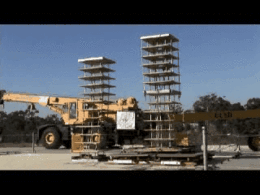Seismic sustainability
| Educational level: this is a research resource. |
Seismic sustainability ( also called Seismic fitness) stands for ability of buildings or civil engineering structures to perform their basic operational functions with seismic risk limited to acceptable level. Seismic sustainability may be considered the paramount goal of earthquake engineering[1] which is concerned with protecting society, the natural and the man-made environment from the earthquake hazards.[2]

For any particular structural object and earth shaking intensity, seismic sustainability is not universal. It depends on a particular type of challenge: e.g., the soil conditions, 3-D directions of shaking, possibility of tsunami and its magnitude, etc.
A seismically sustainable structure does not necessarily have to be extremely strong or expensive. It just has to withstand predetermined seismic impacts while sustaining an acceptable level of damage.
The most powerful and budgetary tools for upgrading seismic sustainability of buildings and structures are vibration control technologies and, in particular, base isolation.[4]
References
[edit | edit source]- ↑ Valentin Shustov (2012), "Seismic fitness: on some features of earthquake engineering," http://nees.org/resources/4469/download/Seismic_fitness.pdf.
- ↑ Bozorgnia, Yousef; Bertero, Vitelmo V. (2004). Earthquake Engineering: From Engineering Seismology to Performance-Based Engineering. CRC Press. ISBN 978-0849314391.
- ↑ Earthquake Protector: Shake Table Crash Testing
- ↑ To Seismic Sustainability through Earthquake Protector
| Wikibooks has a book on the topic of Seismic fitness. |
| Look up seismic sustainability in Wiktionary, the free dictionary. |
